Traditional German Spaetzle Recipe
This post may contain affiliate links. See my disclosure policy.
One of Germany’s most popular and beloved foods, here is a fool-proof and authentic German Spaetzle recipe, just the way my Mutti and Oma made it! Perfect texture and perfect flavor, these are just like you know and love them from the Swabia region of Southern Germany where they originated!
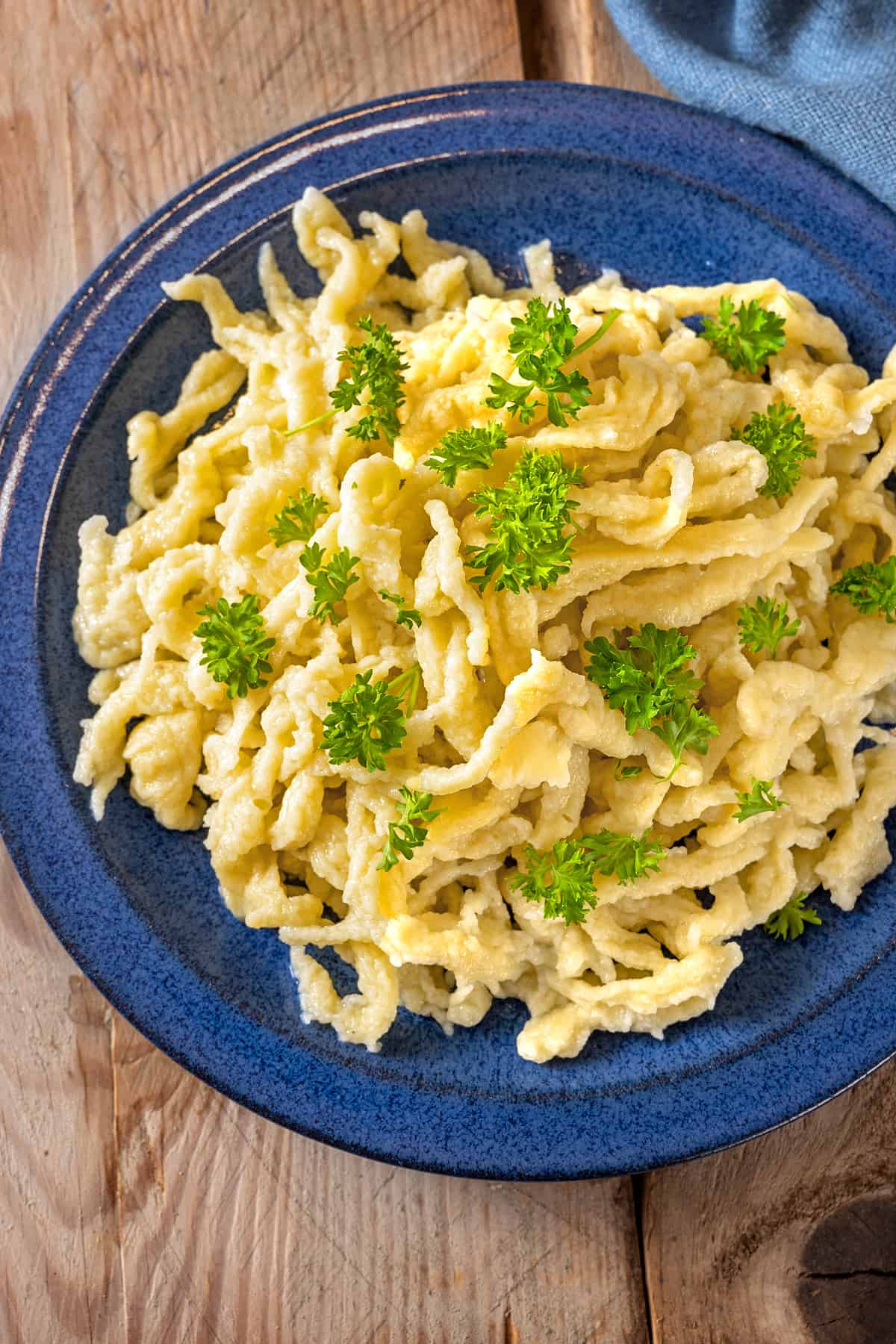
What is Spaetzle?
One of the most beloved foods in Germany that tourists go home talking about is Spaetzle, the famous German egg noodles from the Baden-Württemberg region of southwest Germany. This area is also known as Schwabenland, or Swabia. I grew up in Stuttgart, the capital of Baden-Württemberg, watching my Mom and Oma make Spätzle – I learned from the best!
Swabia is home to some of Germany’s best food (many, including myself, will argue it’s home to the best food in all of Germany). And that’s saying a lot because every region of Germany has amazing food. Swabia is known for its soups, sauces, meats, wursts, and salads, to name a few. It’s also home to some unique varieties of pasta including Spätzle, Schupfnudeln and Maultaschen.
Today we’re featuring Spätzle, a Swabian specialty that is also enjoyed in Austria and Switzerland. Spaetzle is a special type of egg noodle that is enjoyed with sauces and gravies as well as incorporated into a variety of different dishes. One example is Käsespätzle (a cheese spatzle casserole with crispy fried onions). Where did the name “Spätzle” originate? It comes from the German word Spatzen, meaning “little sparrows”, because that’s what they were thought to resemble when they were traditionally made by hand.
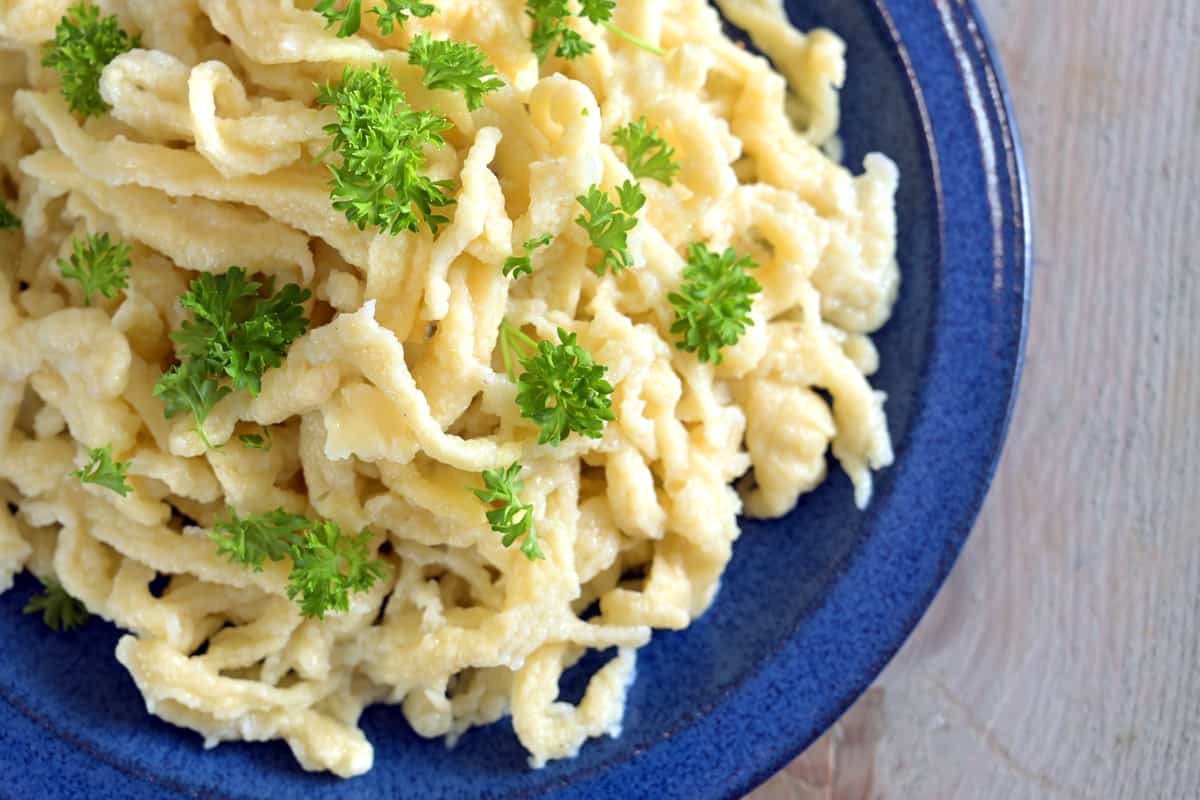
Spaetzle Ingredients
Spaetzle is a type of pasta and as such is made with a very few, simple ingredients that you’ll already have in your pantry. Here’s what you need:
- All-purpose flour: this creates a tender Spaetzle that still has a nice chewy texture.
- Eggs: these add richness and contribute to texture.
- Milk or water: You can use either but I prefer milk as it adds richness.
- Salt: enhances the flavor.
- Nutmeg: this is optional and is not traditional, though many German cooks today like to add it for flavor.
Spaetzle Recipe
Let’s get started!
This spaetzle recipe uses a stand mixer to knead/mix the dough. This is actually the first time I’ve made it that way. I’ve always done it by hand (you “knead” it by vigorously whipping it in a bowl with a spoon – over and over and over for around 20 minutes. It’s a lot of work!) I decided to to try it with a stand mixer instead and it turned every bit as good – and it sure saves a lot of muscle strain!
Add the flour and salt in the bowl of a stand mixer. Stir to combine. Crack four eggs into a bowl and whisk to combine. Make a well in the center of the flour and add the eggs. Add the milk or water and with the paddle attachment (I initially tried the dough hook and it didn’t work well), knead/mix the dough on the “2” setting for about 10 minutes to get a cohesive batter. Add more flour if the mixture is too runny, or more milk if it is too stiff.
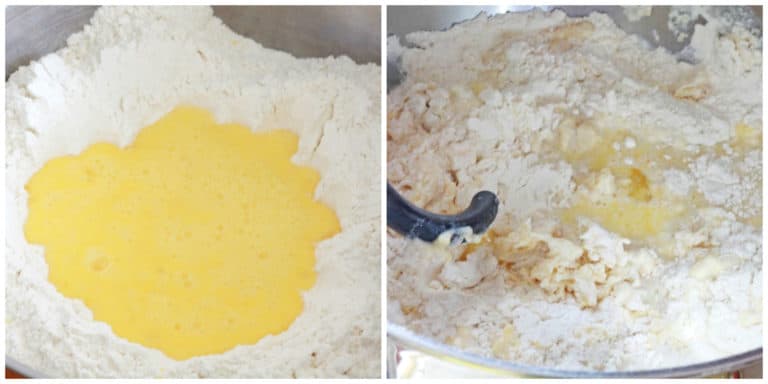
Pro Tip: How to Know When the Spätzle Batter is Ready
The batter is done when “bubbles” begin to form. After about 10 minutes of beating, use a wooden spoon and scoop and pull to stretch the batter; if bubbly holes appear, the dough is done. If not, continue “kneading” with the mixer for another minute or two, repeating the “test” process. See the bubble hole below?
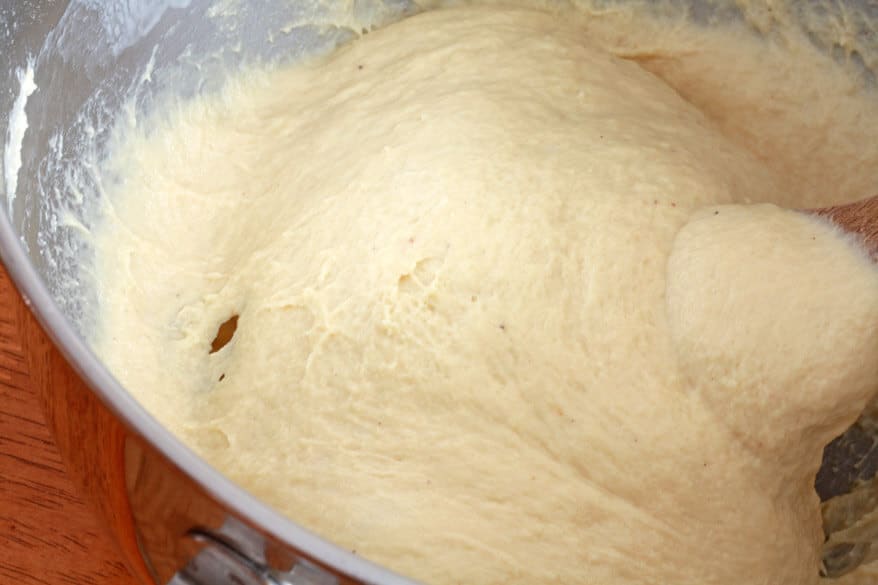
When those bubbly holes start appearing you know your batter is done.
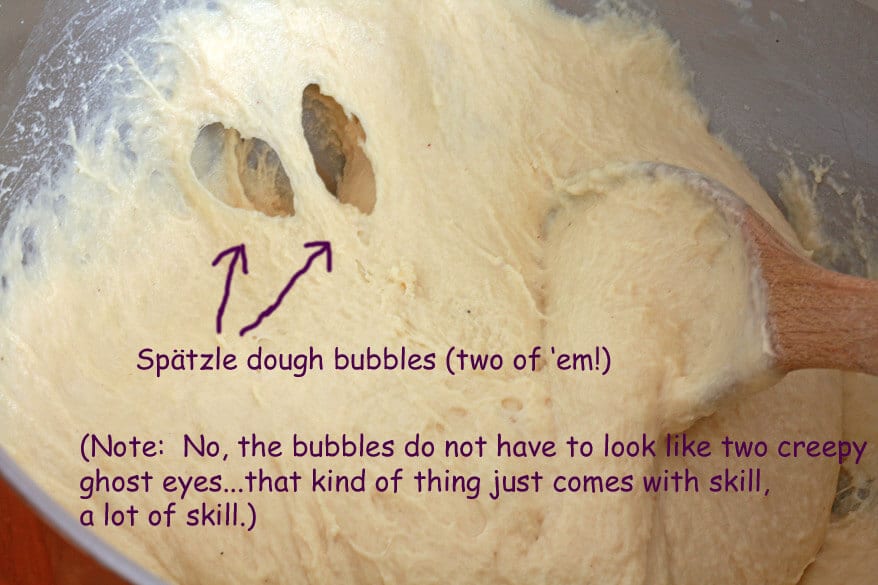
What Is the Best Spätzle Maker?
Now that the batter is read it’s time to make the Spätzle. And when it comes to the Spaetzle maker, there are a few options to choose from. Traditionally, Spätzle was made by hand using a Spätzlebrett, or Spaetzle board. You would rub a slab of dough out onto a wetted board and use a pastry cutter or long sharp knife to quickly cut off strands of the dough into simmering water. Swabian women of previous generations were highly skilled at this and could do it so fast it would make you dizzy to watch. Nowadays most Germans use a Spätzle maker (and even more just buy it ready made at the store. It’s the “convenience generation”).
Besides the traditional Spätzle board there are a few different kinds of Spätzle makers out there that you can find online:
- Spätzle Press (below left): That is my Spaetzle maker that I brought with me from Germany when I moved to the U.S. and it’s awesome. This kind is pricey but it will last a lifetime. It’s called the Original Kull Spätzle Maker and is made in Germany. It’s built like a tank and will become a family heirloom you can pass down for generations. Another brand that is much cheaper and is also made in Germany is this Westmark Spätzle Maker. These Spätzle presses can also be used as potato ricers.
- Spätzle Scraper (below right): Another option is the Küchenprofi Spätzle Lid & Scraper. I’ve used this one as well with good results and it’s much cheaper. It produces a shorter, stubbier spatzle noodle. Alternatively you can also use a metal steamer because it’s similarly constructed with large holes. You place some of the dough in the steamer over the simmering water and scrape the dough through the holes.
- Spätzle Plane: A third option is the Küchenprofi Spätzle Plane with Pusher, which is my least favorite as it can be a little clumsy, messy, and more difficult to work with but I know people who use it.
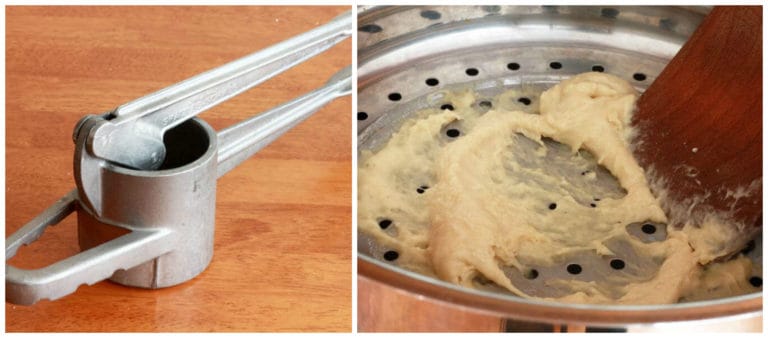
My personal favorite is the Spätzle press and that’s what I’m using in the pictures below. Place the Spaetzle maker over a pot of lightly salted simmering water and scoop some dough into it.
Press the Spätzle maker down to squeeze the Spätzle noodles out into the simmering water. Simmer the Spätzle for about 2-3 minutes or until they float to the top.

Using a slotted spoon, transfer the Spätzle to a colander and then immediately put them in a bowl of very cold water. This helps them firm up to the desired consistency.
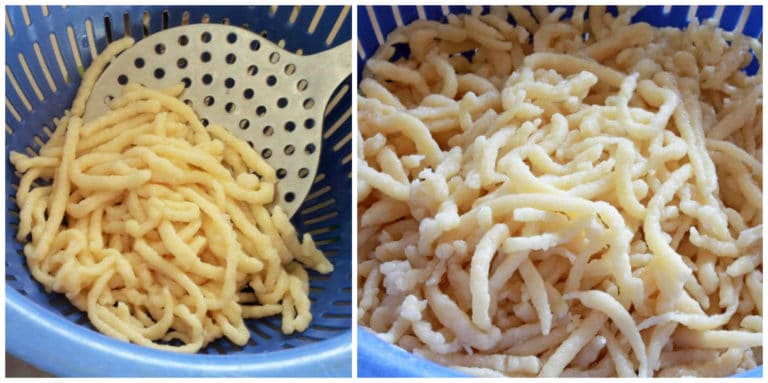
Drain the Spätzle again and toss with a little oil or melted butter to keep them from sticking.
Spätzle will keep in the fridge for at least a couple of days and then heated to serve. Melt some butter in a pan and toss the Spaetzle in it to warm through.
Storage & Freezing
Spaetzle can be made in advance, cooled, and stored in a covered container in the fridge where it will keep for 3-4 days. To reheat it you can microwave it in a microwave-safe container or, my favorite way, is to melt some butter in a large skillet, add the Spätzle and heat through. Spaetzle also freezes well for up 3 months: put it in a freezer-safe container and let it thaw overnight in the fridge. It can be reheated in the microwave in a covered container so that it doesn’t dry out, or you can melt some butter in a pan and toss the Spaetzle in it until warmed through.
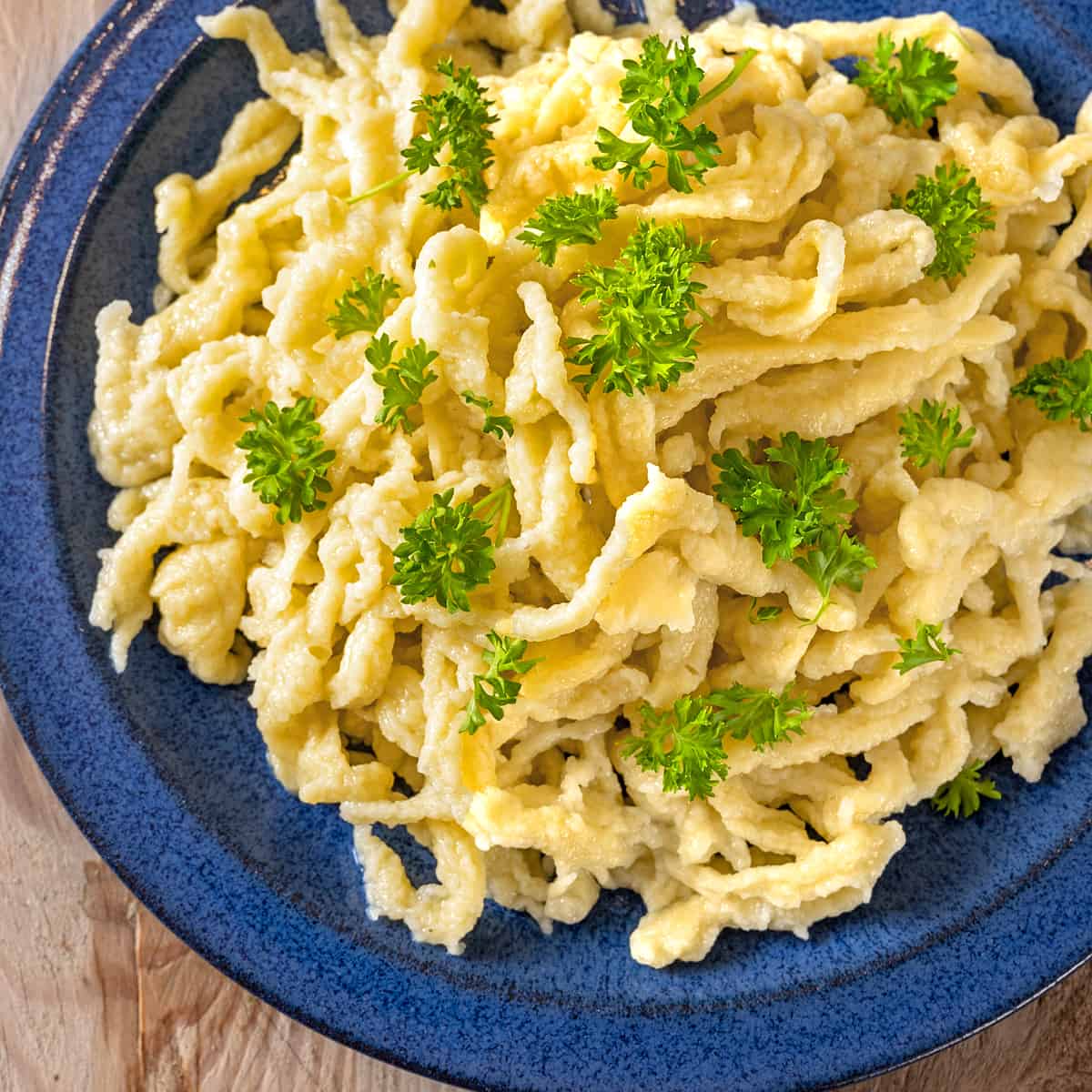
What to Serve with Spaetzle
Spaetzle is very versatile and can be served a variety of ways. Here are a ways to serve spaetzle:
- Buttered Spätzle: This is one of the simplest and most traditional ways to serve spaetzle. After boiling and draining the cooked spaetzle, toss them with melted butter and sprinkle with chopped parsley.
- German Cheese Spaetzle (Käsespätzle): Another Swabian classic and personal favorite, try my recipe for Käsespätzle (pictured below).
- With Sauces and Gravies: Spaetzle can be served with any sauce or gravy, like my favorite German Rahm Sauce, Onion Gravy, or Mushroom Gravy. Serve it with my classic German Goulash, Geschnetzeltes or Königsberger Klopse.
- With Meat Dishes: Spaetzle is the perfect choice to serve with any saucy meat dish like Jagerschnitzel, Rouladen, Sauerbraten, Pot Roast and Tri Tip Roast. It can also accompany your Schweinshaxe and Frikadellen.
- Pasta Salads: For a variation on traditional pasta salad, toss the spaetzle with fresh vegetables, herbs, a vinaigrette, and some diced cheese and ham.
- In Soups: In some regions, spaetzle is added to soups, much like dumplings. Drop small portions of spaetzle dough directly into simmering soup and let them cook until they float to the surface as in this Gaisburger Marsch and German Pea Soup.
Guten Appetit!
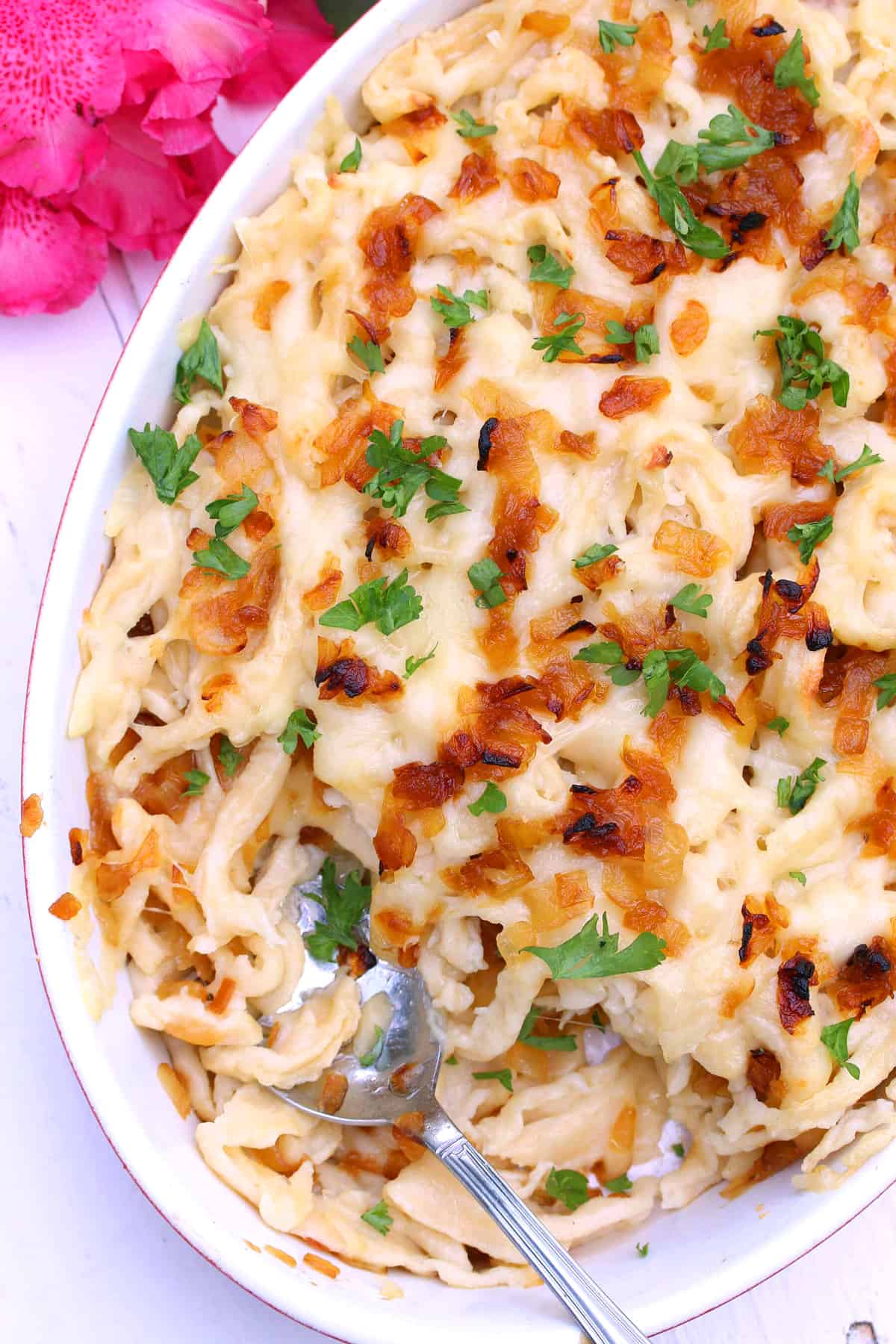
For more favorite traditional German dishes be sure to try my:
- Kaesespaetzle
- Rouladen
- Sauerbraten
- German Goulash
- Maultaschen
- Schnitzel
- Bread Dumplings
- German Potato Dumplings
- Zwiebelkuchen
- German Bread (Vollkornbrot)
- Bratwurst
- Currywurst
- German Potato Salad
- Rotkohl
Save This Recipe
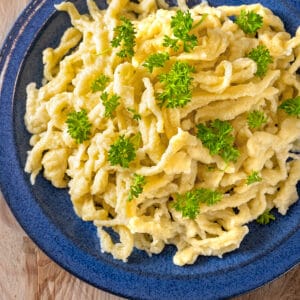
Traditional German Spaetzle Recipe
Equipment
Ingredients
- 2 cups all-purpose flour (you can also use whole wheat flour)
- 1 1/2 teaspoons salt
- 1/8 teaspoon freshly ground nutmeg , optional (not traditional but adds a nice flavor)
- 4 large eggs
- 1/2 cup milk or water + more as needed (milk produces a richer Spaetzle) (**add more flour if the dough is too runny, add more milk or water if it's too stiff)
- butter for serving
Instructions
- The Spätzle batter can be mixed by hand or by using a stand mixer which is much easier. Add the flour, salt and nutmeg (if using) to the bowl of a stand mixer. Stir to combine. Crack the eggs into a small bowl and whisk them. Make a well in the center of the flour mixture and pour the eggs in it. Add the milk (start with using slightly less and add more as needed). Attach a paddle attachment to the stand mixer and "knead" the dough for about 10 minutes or until bubbles appear (see pictured instructions for details). After 10 minutes or so of beating, use a wooden spoon to scoop and pull the dough. If bubbles/holes appear, the dough is done
- Bring at least 2 quarts of lightly salted water to a boil, then reduce to a simmer. Using a Spätzle maker of your choice (I use and prefer the Spätzle press), press the noodles into the simmering water and cook for about 2-3 minutes, or until the noodles float to the top. Use a slotted spoon to transfer the noodles to a colander to drain the hot water and then to large bowl of ice water (this firms them up for a better/chewier texture). After a minute or two transfer them to a colander to drain completely. Before serving, warm them through in a skillet with some melted butter.
- Make Ahead: The Spaetzle can be stored in the fridge for at least a couple of days and then reheated. Melt some butter in a large skillet and toss the Spätzle in it to heat through. Alternatively they can be microwaved in a covered dish.
Notes
Nutrition
Originally published on The Daring Gourmet on August 3, 2013



















I must say I hated it when my !other bought the Spaetzle press.I would not eat them.You need to use the Spaetzle Brett as far as I am concerned,but that is the only way I will eat them.Enjoyed your demonstration. Thank you for that.By the way I am from Schrambrg I’m Schwartzwald,live in Florida now!!!
I prefer the shape of Spätzle that’s made on the board, even though of course it tastes the same no matter what the shape. But most of the time, just for the sake of speed and convenience, I use the press. Greetings to Schramberg and Florida!
I came across your recipe by chance, looking for an English recipe for a friend. I was pleasantly surprised to see the fourth picture, the Rathaus in Grötzingen from where I am.
For the Spätzle: As a rule of thumb, I use (number of portions + 1) eggs, salt to taste, a pinch of nutmeg, and milk (no water, Grötzingen is in Baden, after all) to get the dough to the right consistency for the method, the bubbles you describe for the Spätzleschwob and a bit runnier for scraping.
Thanks for visiting, Cornelius, and greetings to Grötzingen! I agree – I’ve made mine both ways, with milk and water, though like you I prefer the consistency of milk. And yes, if I’m using the board/scraping method what I’ll usually do is just wet the board down between scrapings to make the dough a bit runnier and glide off more easily.
Baden Württemberg includes STUTTGART – doesn’t it! That’s where my Spaetzles recipe comes from: lots of eggs and water, no milk. I am using my mother’s old press which is at least 70 years old. – Love your recipes.
Eva
It sure does, Eva. Stuttgart is where I’m from and it’s the capital of Baden-Württemberg. That’s really neat that you have your mother’s old press – such a treasure.
I understand this would be very unconventional, but I’m wondering if you could use the fettuccine or spag.attachment for the kitchenaid stand mixer?
Hi Heidi, as long as it works, that’s all that matters! :) I’m not sure how well it would work though because Spätzle dough is wetter and softer than regular pasta dough. My fear is it would result in a big mess. Still, it’s worth the try. If you give it a go let us know how it went!
I made this today, and it was delicious. I didn’t grown up eating homemade spaetzle, so learning to make them has been frustrating. This dough, however, was relatively easy to handle and cooked up perfectly al dente.
I especially appreciated the clear instructions and photos for the kneading process. I suspect that’s where my past attempts went awry! Super helpful to have a visual reference for the correct consistency.
Despite the cautionary tales in the comments, I tried using my ricer anyway. Unsurprisingly, the close holes did result in some clumping. Happily, I was able to break up the worst of it by gently agitating them with a fork immediately after dropping them in the water. I didn’t achieve long strands, but it made passable (albeit somewhat irregular) short pieces.
I’m eager to try these again, even if I don’t have the method down pat yet. It got rave reviews for texture and flavour from the family, too. I foresee a spaetzle maker on my Christmas wishlist for this year. :D Thanks so much for this great recipe!
That’s wonderful, Flora, I’m to to hear it was such a hit, thank you! And I think you’ll be very happy with your Christmas gift :)
Hi there,
tried your recipe tonight with mixed results. Although my potato ricer has a plate that is allegedly a spatzle one I don’t think the holes were far enough apart (you’d think an Aldi gadget would get it right!) and I had trouble with clumping. But the ones that didn’t clump tasted terrific and were voted a success. The ones that did clump shall be sliced up and turned into Kasespatzle tomorrow! A perfect winter dish which we very much enjoyed.
BTW – the reason I used your recipe not one of the other ones google produced was because of the thickness of the dough – knowing how it was originally made the thin runny mix on some other websites just didn’t make sense.
Thanks!
Di
Hi Di, thanks for the feedback and for choosing our recipe! I’m glad it turned out great aside from the potato ricer fiasco. I’m not a fan of using ricers for Spätzle for the very reason you noted. But using the clumped up Spätzle for Käsespätzle is the perfect call!
Kim,
Thanks for the words of encouragement.
I’ll keep trying till it comes out right.
I always like my recipes to be as close to
the original/authentic they can be. I think keeping the
traditional is best, sometimes more work….BUT worth it!
Thanks again….keep up the good work.Sincerely, Dan
Hello Kim,
I was pretty irritated when I wrote you last,mainly I had a kitchen full of family waiting for my special surprise “noodle” and what a flop.ANWAY…everybody really enjoyed the Sauerbraten that I made with a venison roast.
I Will try this again and I’m buying a spatzle press today!
Thanks for getting back to me and I apologize for being so gruff!
When that press gets here I’m making that Mac and cheese.or the Geschnetzletes,
they both sound delicious. Thanks again, Sincerely Dan
No problem, Dan, I appreciate that. I’d be frustrated too if I put time and effort into something that was a flop, especially if there were hungry people there waiting on me! I re-emphasized in the actual recipe box what I said in the step-by-step instructions, which is to use a spoon to scoop and pull at the dough halfway into the mixing process and then again later to test for doneness. As soon as bubbles/holes appear when you pull the dough with the spoon the dough is done, no need to mix it any longer. That may take longer than 15 minutes or it may take less. Making great Spätzle is something of an art that takes some practice to get a feel for what the consistency of the dough should be like. Traditionally no one would have timed how long to beat the dough (nor would they have used a stand mixer), they would have just beat it by hand with a wooden spoon it until it looked and felt right. After another try or two you’ll become the Spätzle King! :)